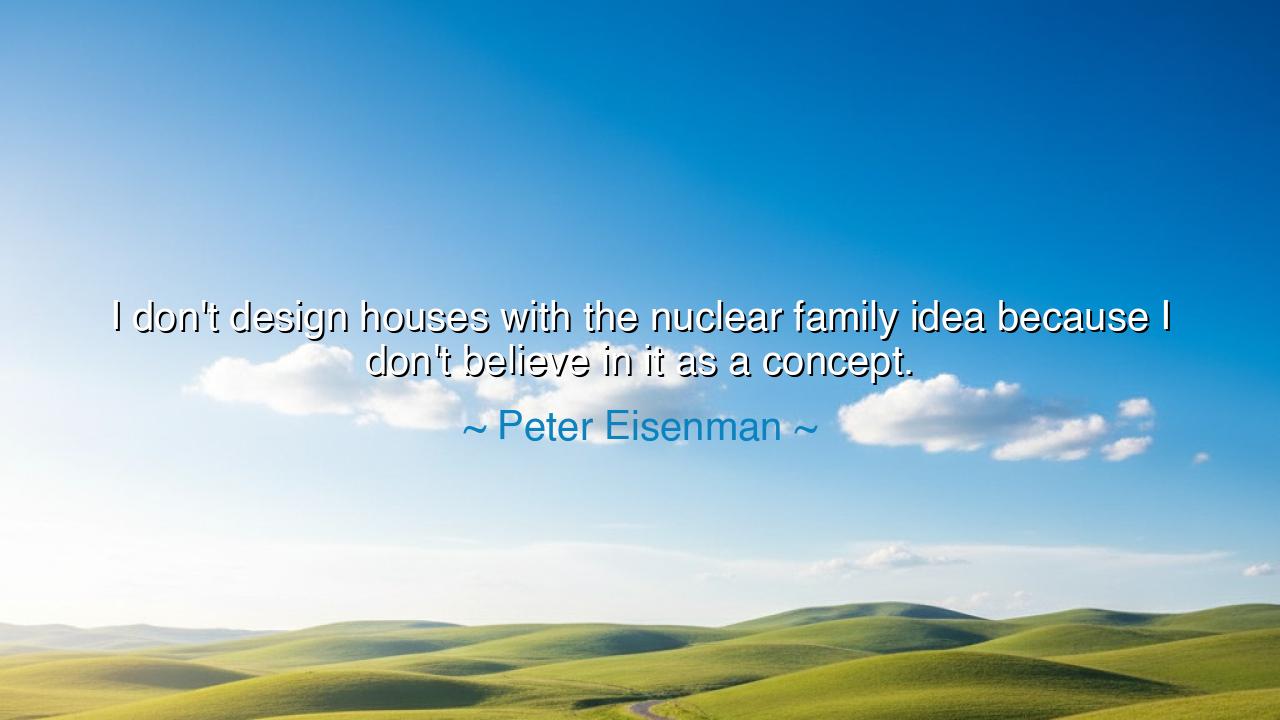
I don't design houses with the nuclear family idea because I
I don't design houses with the nuclear family idea because I don't believe in it as a concept.






“I don’t design houses with the nuclear family idea because I don’t believe in it as a concept.” Thus spoke Peter Eisenman, a philosopher of architecture as much as a builder of it, a man who dared to question not only how we construct walls, but why we live within them as we do. His words are not merely about architecture — they are about society, identity, and the structures, both visible and invisible, that shape the human spirit. In this declaration, Eisenman challenges one of the most deeply embedded assumptions of modern life: the belief that the nuclear family — father, mother, and children — is the natural and eternal form of human dwelling. He saw it instead as a construct, a design of its own — one that limits both the way we live and the way we imagine life could be.
In the ancient world, the idea of family was never confined to a single household. The Greeks lived in the oikos, a home that was both dwelling and microcosm of society, encompassing extended kin, servants, and apprentices — a living organism of relationships and roles. The Romans built the domus as an open, collective space, where business, education, and worship coexisted under one roof. Even in the villages and tribes that predated these civilizations, the home was shared — a place where generations intertwined and survival depended on connection, not separation. It was only in the modern industrial age that humanity withdrew into smaller boxes, each family sealed away like a cell in a hive. It was efficiency, not essence, that birthed the nuclear family — and thus, Eisenman rejects it not as unnatural, but as uninspired.
For Eisenman, to design is to question reality. When he says he does not design houses for the nuclear family, he is declaring war upon conformity — on the idea that architecture must merely serve existing social patterns. He sees the house not as a container of habit, but as an instrument of thought, capable of reshaping how we experience one another. His houses, angular, fragmented, often disorienting, reflect this philosophy: they refuse to comfort, they provoke awareness. To live in one is to awaken, to see that even our most sacred spaces are ideas — and ideas can change. This is what makes his architecture not just structure, but philosophy made visible.
Consider the story of House VI, one of Eisenman’s most famous works. Built in the 1970s for a couple, it defied every expectation of domestic architecture. The stairs split unexpectedly, a column cut through the dining table, and the walls seemed to rebel against the human instinct for order. Many dismissed it as chaos, but Eisenman called it truth. He wanted to strip away comfort, to reveal that the “normal” home — designed for the neat, self-contained family unit — was itself a kind of illusion. In breaking it apart, he forced those who lived there to rethink what “home” truly meant. Was it a place of routine, or a space of exploration? Was it meant to contain, or to liberate?
Eisenman’s rejection of the nuclear family as a design principle speaks to something deeper than architecture. It is a challenge to all systems that confine human experience — social, political, emotional. He reminds us that every structure we inhabit, from our houses to our beliefs, is built from assumptions. When we stop questioning them, we become prisoners within our own creations. Just as the walls of a home can shape behavior, so too can the walls of thought. To design differently is to live differently, to create spaces — physical and spiritual — that welcome diversity, community, and change.
This philosophy resonates beyond his era. In today’s world, families take countless forms: friends who live as kin, single parents raising children with courage, elders and youth cohabiting across generations, communities built not from blood but from love. Eisenman foresaw this truth — that the concept of family is evolving, that architecture must reflect the infinite ways people come together. The house of the future, he implies, should not be a box for a fixed unit, but a canvas for human connection in all its possibilities. To design for one kind of family is to deny the creativity of the human heart.
So, my child, take this teaching beyond the walls of stone and glass. Do not build your life upon narrow blueprints. Question the structures you inherit — in your work, your home, your relationships. Ask: Who was this built for? and Does it still serve who we have become? For every generation must redraw the plan of existence to suit the spirit of its time. The courage to do so is what Eisenman calls design — not the making of objects, but the reshaping of experience.
And thus, remember this: the true architect is not one who builds walls, but one who reimagines the spaces between them. Life itself is a design, and to live well is to take part in its continual reinvention. Be brave enough, like Eisenman, to reject what no longer serves humanity. Build homes — and lives — that reflect not what the world expects, but what the soul envisions. For in that act of creation, you will find the freedom that lies beyond every concept — the freedom to design not just your house, but your world anew.






AAdministratorAdministrator
Welcome, honored guests. Please leave a comment, we will respond soon